2 Dimensiones
Contents
import sklearn
import numpy as np
import pandas as pd
import matplotlib.pylab as plt
import seaborn as sns
from scipy import stats
from scipy import optimize
from scipy.stats import norm
from matplotlib import cm
from scipy.stats import multivariate_normal
from sklearn.model_selection import train_test_split
#Machinig learning models
from sklearn.linear_model import LogisticRegression
from sklearn.svm import SVC
from sklearn.tree import DecisionTreeClassifier
from sklearn.ensemble import RandomForestClassifier
from sklearn.model_selection import ShuffleSplit
def make_meshgrid(x, y, h=0.02):
"""Create a mesh of points to plot in
Parameters
----------
x: data to base x-axis meshgrid on
y: data to base y-axis meshgrid on
h: stepsize for meshgrid, optional
Returns
-------
xx, yy : ndarray
"""
x_min, x_max = x.min() - 1, x.max() + 1
y_min, y_max = y.min() - 1, y.max() + 1
xx, yy = np.meshgrid(np.arange(x_min, x_max, h), np.arange(y_min, y_max, h))
return xx, yy
def plot_contours(ax, clf, xx, yy, **params):
"""Plot the decision boundaries for a classifier.
Parameters
----------
ax: matplotlib axes object
clf: a classifier
xx: meshgrid ndarray
yy: meshgrid ndarray
params: dictionary of params to pass to contourf, optional
"""
Z = clf.predict(np.c_[xx.ravel(), yy.ravel()])
Z = Z.reshape(xx.shape)
out = ax.contourf(xx, yy, Z, **params)
return out
def plot_contoursExact(ax, xx, yy, **params):
"""Plot the decision boundaries for a classifier.
Parameters
----------
ax: matplotlib axes object
clf: a classifier
xx: meshgrid ndarray
yy: meshgrid ndarray
params: dictionary of params to pass to contourf, optional
"""
Z = clf.predict(np.c_[xx.ravel(), yy.ravel()])
Z = Z.reshape(xx.shape)
out = ax.contourf(xx, yy, Z, **params)
return out
import numpy as np
import matplotlib.pyplot as plt
from sklearn.naive_bayes import GaussianNB
from sklearn.svm import SVC
from sklearn.datasets import load_digits
from sklearn.model_selection import learning_curve
from sklearn.model_selection import ShuffleSplit
# https://scikit-learn.org/stable/auto_examples/model_selection/plot_learning_curve.html
def plot_learning_curve(
estimator,
title,
X,
y,
axes=None,
ylim=None,
cv=None,
n_jobs=None,
train_sizes=np.linspace(0.1, 1.0, 5),
):
"""
Generate 3 plots: the test and training learning curve, the training
samples vs fit times curve, the fit times vs score curve.
Parameters
----------
estimator : estimator instance
An estimator instance implementing `fit` and `predict` methods which
will be cloned for each validation.
title : str
Title for the chart.
X : array-like of shape (n_samples, n_features)
Training vector, where ``n_samples`` is the number of samples and
``n_features`` is the number of features.
y : array-like of shape (n_samples) or (n_samples, n_features)
Target relative to ``X`` for classification or regression;
None for unsupervised learning.
axes : array-like of shape (3,), default=None
Axes to use for plotting the curves.
ylim : tuple of shape (2,), default=None
Defines minimum and maximum y-values plotted, e.g. (ymin, ymax).
cv : int, cross-validation generator or an iterable, default=None
Determines the cross-validation splitting strategy.
Possible inputs for cv are:
- None, to use the default 5-fold cross-validation,
- integer, to specify the number of folds.
- :term:`CV splitter`,
- An iterable yielding (train, test) splits as arrays of indices.
For integer/None inputs, if ``y`` is binary or multiclass,
:class:`StratifiedKFold` used. If the estimator is not a classifier
or if ``y`` is neither binary nor multiclass, :class:`KFold` is used.
Refer :ref:`User Guide <cross_validation>` for the various
cross-validators that can be used here.
n_jobs : int or None, default=None
Number of jobs to run in parallel.
``None`` means 1 unless in a :obj:`joblib.parallel_backend` context.
``-1`` means using all processors. See :term:`Glossary <n_jobs>`
for more details.
train_sizes : array-like of shape (n_ticks,)
Relative or absolute numbers of training examples that will be used to
generate the learning curve. If the ``dtype`` is float, it is regarded
as a fraction of the maximum size of the training set (that is
determined by the selected validation method), i.e. it has to be within
(0, 1]. Otherwise it is interpreted as absolute sizes of the training
sets. Note that for classification the number of samples usually have
to be big enough to contain at least one sample from each class.
(default: np.linspace(0.1, 1.0, 5))
"""
if axes is None:
_, axes = plt.subplots(1, 3, figsize=(20, 5))
axes[0].set_title(title)
if ylim is not None:
axes[0].set_ylim(*ylim)
axes[0].set_xlabel("Training examples")
axes[0].set_ylabel("Score")
train_sizes, train_scores, test_scores, fit_times, _ = learning_curve(
estimator,
X,
y,
cv=cv,
n_jobs=n_jobs,
train_sizes=train_sizes,
return_times=True,
)
train_scores_mean = np.mean(train_scores, axis=1)
train_scores_std = np.std(train_scores, axis=1)
test_scores_mean = np.mean(test_scores, axis=1)
test_scores_std = np.std(test_scores, axis=1)
fit_times_mean = np.mean(fit_times, axis=1)
fit_times_std = np.std(fit_times, axis=1)
# Plot learning curve
axes[0].grid()
axes[0].fill_between(
train_sizes,
train_scores_mean - train_scores_std,
train_scores_mean + train_scores_std,
alpha=0.1,
color="r",
)
axes[0].fill_between(
train_sizes,
test_scores_mean - test_scores_std,
test_scores_mean + test_scores_std,
alpha=0.1,
color="g",
)
axes[0].plot(
train_sizes, train_scores_mean, "o-", color="r", label="Training score"
)
axes[0].plot(
train_sizes, test_scores_mean, "o-", color="g", label="Cross-validation score"
)
axes[0].legend(loc="best")
# Plot n_samples vs fit_times
axes[1].grid()
axes[1].plot(train_sizes, fit_times_mean, "o-")
axes[1].fill_between(
train_sizes,
fit_times_mean - fit_times_std,
fit_times_mean + fit_times_std,
alpha=0.1,
)
axes[1].set_xlabel("Training examples")
axes[1].set_ylabel("fit_times")
axes[1].set_title("Scalability of the model")
# Plot fit_time vs score
axes[2].grid()
axes[2].plot(fit_times_mean, test_scores_mean, "o-")
axes[2].fill_between(
fit_times_mean,
test_scores_mean - test_scores_std,
test_scores_mean + test_scores_std,
alpha=0.1,
)
axes[2].set_xlabel("fit_times")
axes[2].set_ylabel("Score")
axes[2].set_title("Performance of the model")
return plt
2 Dimensiones¶
Caso Bivariante
$\rho$ coeficiente de correlación, media es $(0, 0)$
La matriz de covarianzas viene dada por:
Otra forma de escribirla puede ser como sigue
Dataset¶
Y |
X_1 |
X_2 |
|---|---|---|
$Y^{1}$ |
$X_1^{1}$ |
$X_2^{1}$ |
$Y^{2}$ |
$X_1^{2}$ |
$X_2^{1}$ |
. |
. |
. |
. |
. |
. |
. |
. |
. |
$Y^{m}$ |
$X_1^{m}$ |
$X_2^{1}$ |
def data( mu=[1,1], mu1=[-2,2], cov=[[1.0, 0.0], [0.0, 1.0]] , cov1= [[1.0, -0.5], [-0.5, 1.0]] ):# Caso mas visible
rv = multivariate_normal(mu, cov)
rv1 = multivariate_normal(mu1, cov1)
return rv, rv1
def sample(N1= 1000, N2 = 100, r = 0.2):
X_t = np.concatenate([rv.rvs(N1, random_state = r ), rv1.rvs(N2,random_state = r)]) # Todos los datos en la misma distribución,
y = np.concatenate([np.zeros(N1), np.ones(N2) ] )
return X_t, y
def graph_gaussian_contour(x, y, pos, rv, rv2):
fig = plt.figure(figsize = (12,6))
ax = fig.add_subplot(1, 2, 1, projection='3d')
surf1 = ax.plot_surface(x,y, rv.pdf(pos) + rv1.pdf(pos), cmap = cm.coolwarm,
linewidth = 0, antialiased = False)
ax.set_xlabel("$X_1$")
ax.set_ylabel("$X_2$")
ax.set_zlabel("$PDF(X_1,X_2)$")
#=============================================================
ax = fig.add_subplot(1, 2, 2)
cs1 = ax.contourf(x, y, rv.pdf(pos) + rv1.pdf(pos) )
#cs2 = ax.contourf(x1, y1, rv1.pdf(pos1) )
ax.set_xlabel("$X_1$")
ax.set_ylabel("$X_2$")
#ax.set_xlim(-2.5,2.5)
#ax.set_ylim(-2.5,2.5)
cbar = fig.colorbar(cs1)
# Histograma de los datos sinteticos a estudiar
rv, rv1 = data( mu=[1.2,1.4], mu1=[1.4,-1.4],
cov=[[1.0, -0.8], [-0.8, 1.0]] ,
cov1= [[1.0, 0.8], [0.8, 1.0]])
#Mesh para la grafica en 3D
x, y = np.mgrid[-4:4:.1, -4:4:.1]
pos = np.dstack((x, y))
graph_gaussian_contour(x, y, pos, rv, rv1)
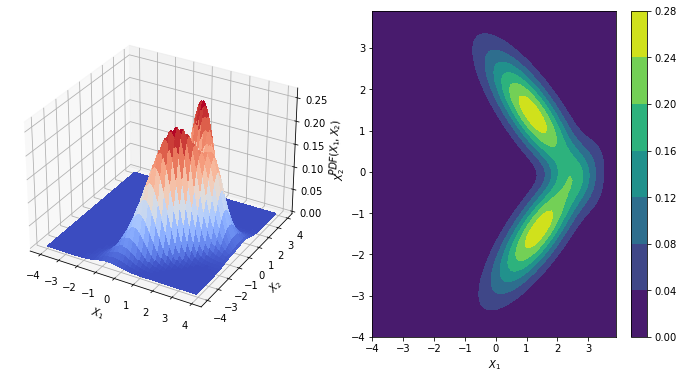
rv, rv1 = data( mu=[1.2,1.4], mu1=[1.4,-1.4],
cov=[[1.0, -0.8], [-0.8, 1.0]] ,
cov1= [[1.0, 0.8], [0.8, 1.0]])
X_t, y = sample(N1 = 100, N2 = 100, r = 10)
plt.plot(X_t[y==0][:,0],X_t[y==0][:,1],"ro", alpha=0.4)
plt.plot(X_t[y==1][:,0],X_t[y==1][:,1],"bo", alpha=0.4)
plt.xlabel("X1")
plt.ylabel("X2")
plt.show()
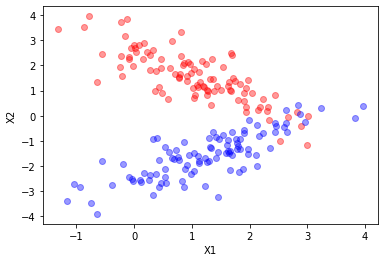
Curvas de aprendizaje¶
Permite definir las metricas del modelo, define que también es sepración realizada por el estimador. Permite entender cuando se presenta sobreajuste y bajoajuste en un modelo de machining learning.
Su construccion puede ser realizada como sigue:
El datasets se divide K veces en entrenamiento y validación.
x_t_index = [0, 1, 2, 3 4, 5, 6, 7, 8, 9]
div |
train_index |
test_index |
|---|---|---|
1 |
[9 8 6 7 0 4 2] |
[3 1 5] |
2 |
[0 7 9 3 2 1 4] |
[5 8 6] |
3 |
[8 6 5 2 9 7 3] |
[0 1 4] |
4 |
[5 9 4 6 3 0 2] |
[7 8 1] |
k=5 |
[3 5 8 1 7 6 0] |
[9 2 4] |
Se construyen subconjunto del dataset de entrenamiento para entrenar el estimador.
split |
train_index(div 1) |
train_index(div 2) |
… |
execution |
|---|---|---|---|---|
1 |
[9, 8] |
[0, 7] |
… |
i |
2 |
[9, 8, 6] |
[0, 7, 9] |
… |
i |
3 |
[9,8,6, 7, 0] |
[0, 7, 9,3] |
… |
i |
4 |
[9,8,6, 7, 0, 4] |
[0, 7, 9,3, 2] |
… |
i |
5 |
[9, 8, 6] |
[0, 7, 9,3, 2,1] |
… |
i |
6 |
[9,8,6, 7, 0, 4,2] |
[0, 7, 9,3, 2,1,4] |
… |
i |
Se computan los scores para los datos de entrenamiento y validación.
Se promedian los scores de los datos de entrenamiento y validación
Overfitting:¶
Modelo con una complejidad alta, por ejemplo querer ajutar una funcion lineal con un polinomio de grado superior. En este caso decimos que el sistema se esta aprendiendo los datos de memoria.
Para las covarianzas mostradas, realiza las siguientes pruebas, ¿la Separacion de los datos mejora con el aumento de datos?
El hiperparametro gamma, por ahora, permitira definir la complejidad de la frontera. Que pasa si se disminuye el valor de gamma?
q = X_t[0:10]
cv = ShuffleSplit(n_splits = 5, test_size=0.3, random_state=None)
for train_index,test_index in cv.split(q):
print(train_index,test_index)
[7 0 2 6 5 4 8] [9 1 3]
[1 3 8 9 0 6 4] [7 5 2]
[9 4 8 7 6 3 5] [2 1 0]
[9 2 4 6 1 3 8] [0 7 5]
[3 6 0 4 9 2 8] [5 7 1]
len(X_t)
200
rv, rv1 = data( mu=[1.2,1.4], mu1=[1.4,-1.4],
cov=[[1.0, -0.8], [-0.8, 1.0]] ,
cov1= [[1.0, 0.8], [0.8, 1.0]])
X_t, y = sample(N1 = 120, N2 = 120, r = 10)
X_train, X_test, y_train, y_test = train_test_split(X_t, y, test_size = 0.2,
random_state=1)
clf = SVC(gamma = 10.0)
clf.fit(X_train, y_train)
fig, ax = plt.subplots()
X0, X1 = X_train[:, 0], X_train[:, 1]
xx, yy = make_meshgrid(X0, X1)
plot_contours(ax, clf, xx, yy, cmap=plt.cm.coolwarm, alpha=0.8)
plt.plot(X_train[y_train==0][:,0],X_train[y_train==0][:,1],"bo", alpha=1)
plt.plot(X_train[y_train==1][:,0],X_train[y_train==1][:,1],"ro", alpha=1)
print(f"Training error:{clf.score(X_train, y_train):.3f}")
print(f"Test error: {clf.score(X_test, y_test):.3f}" )
fig, axes = plt.subplots(3, 1, figsize=(8, 14))
title = "Learning Curves (Naive Bayes)"
# Cross validation with 100 iterations to get smoother mean test and train
# score curves, each time with 20% data randomly selected as a validation set.
cv = ShuffleSplit(n_splits=100, test_size=0.2, random_state=0)
#clf = SVC(gamma = 20.0)
#clf.fit(X_t, y)
plot_learning_curve(clf, title, X_t, y, axes=axes[0:,], ylim=(0.8, 1.01), cv=cv, n_jobs=4)
plt.show()
Training error:0.979
Test error: 0.896
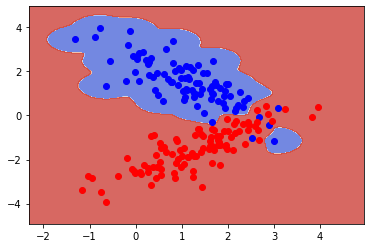
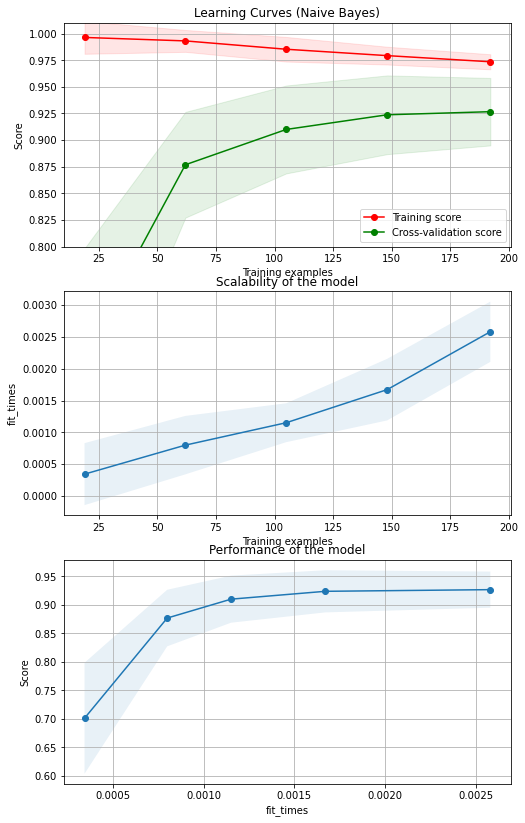
Underfitting¶
No se obtiene la naturaleza subyancente de los datos, el modelo ajustado presentan un error en la estimación de la frontera desfasada respecto a la frontera Bayesiana
#variar la cantida de datos
rv, rv1 = data( mu=[1.4,1.4], mu1=[1.4,-1.4],
cov=[[1.0, -0.8], [-0.8, 1.0]] ,
cov1= [[1.0, 0.8], [0.8, 1.0]])
X_t, y = sample(N1 = 40, N2 = 40, r = 10)
X_train, X_test, y_train, y_test = train_test_split(X_t, y, test_size = 0.2,
random_state=1)
clf = SVC(gamma = 0.001)
clf.fit(X_train, y_train)
fig, ax = plt.subplots()
X0, X1 = X_train[:, 0], X_train[:, 1]
xx, yy = make_meshgrid(X0, X1)
plot_contours(ax, clf, xx, yy, cmap=plt.cm.coolwarm, alpha=0.8)
plt.plot(X_train[y_train==0][:,0],X_train[y_train==0][:,1],"bo", alpha=1)
plt.plot(X_train[y_train==1][:,0],X_train[y_train==1][:,1],"ro", alpha=1)
print(f"Training error:{clf.score(X_train, y_train):.3f}")
print(f"Test error: {clf.score(X_test, y_test):.3f}" )
fig, axes = plt.subplots(3, 1, figsize=(8, 6))
title = "Learning Curves (Naive Bayes)"
# Cross validation with 100 iterations to get smoother mean test and train
# score curves, each time with 20% data randomly selected as a validation set.
cv = ShuffleSplit(n_splits=100, test_size=0.2, random_state=0)
#clf = SVC(gamma = 20.0)
#clf.fit(X_t, y)
plot_learning_curve(clf, title, X_t, y, axes=axes, ylim=(0.3, 1.01), cv=cv, n_jobs=4)
plt.show()
Training error:0.547
Test error: 0.375
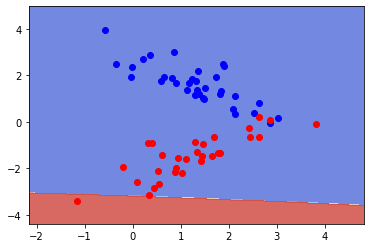
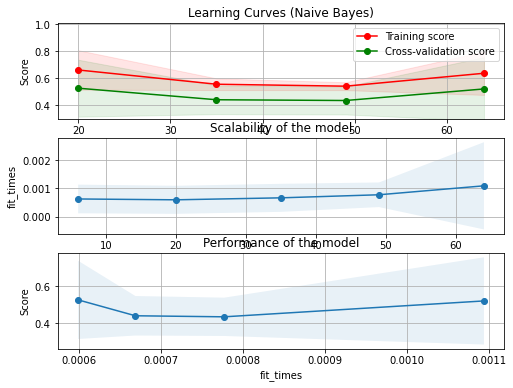
Underfiting¶
rv, rv1 = data( mu=[1,1], mu1=[-2,2],
cov=[[1.0, -0.8], [-0.8, 1.0]] ,
cov1= [[1.0, 0.5], [0.5, 1.0]])
X_t, y = sample(N1 = 60, N2 = 10, r = 10)
X_train, X_test, y_train, y_test = train_test_split(X_t, y, test_size = 0.2,
random_state=1)
clf = SVC(gamma = 0.001)
clf.fit(X_train, y_train)
fig, ax = plt.subplots()
X0, X1 = X_train[:, 0], X_train[:, 1]
xx, yy = make_meshgrid(X0, X1)
plot_contours(ax, clf, xx, yy, cmap=plt.cm.coolwarm, alpha=0.8)
plt.plot(X_train[y_train==0][:,0],X_train[y_train==0][:,1],"bo", alpha=1)
plt.plot(X_train[y_train==1][:,0],X_train[y_train==1][:,1],"ro", alpha=1)
print(f"Training error:{clf.score(X_train, y_train):.3f}")
print(f"Test error: {clf.score(X_test, y_test):.3f}" )
Training error:0.875
Test error: 0.786
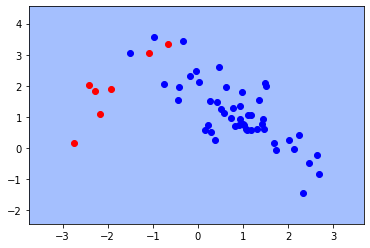
Model Selection and Train/Validation/Test Sets¶
[1] Reference http://cs229.stanford.edu/syllabus.html
Just because a learning algorithm fits a training set well, that does not mean it is a good hypothesis. It could over fit and as a result your predictions on the test set would be poor. The error of your hypothesis as measured on the data set with which you trained the parameters will be lower than the error on any other data set.
Given many models with different polynomial degrees, we can use a systematic approach to identify the ‘best’ function. In order to choose the model of your hypothesis, you can test each degree of polynomial and look at the error result.
One way to break down our dataset into the three sets is:
Training set: 60%
Cross validation set: 20%
Test set: 20%
We can now calculate three separate error values for the three different sets using the following method:
Optimize the parameters in Θ using the training set for each polynomial degree.
Find the polynomial degree d with the least error using the cross validation set.
Estimate the generalization error using the test set with J_{test}
This way, the degree of the polynomial d has not been trained using the test set.
Tarea :
3.1 Para esta situación tomar el 20% como datos para realizar la validacion cruzada y el 80% para realizar el entrenamiento. Construir una curva del score en función del parametro gamma del clasificador que se esta empleando. ¿Cual presenta una mejor solucion al problema?.
3.2 Construir las curvas de aprendizaje estadístico para el modelo descrito, comprobar que la solución es similar a la esperada a través de sklean. a 3.3 Elegir, los párametros adecuados para los centros de medias y las matrices de covarianzas y mostrar Mostrar un ejemplo de Overfitting underfitting con el algoritmo generados construido por ustedes. Analizar los resultados.
